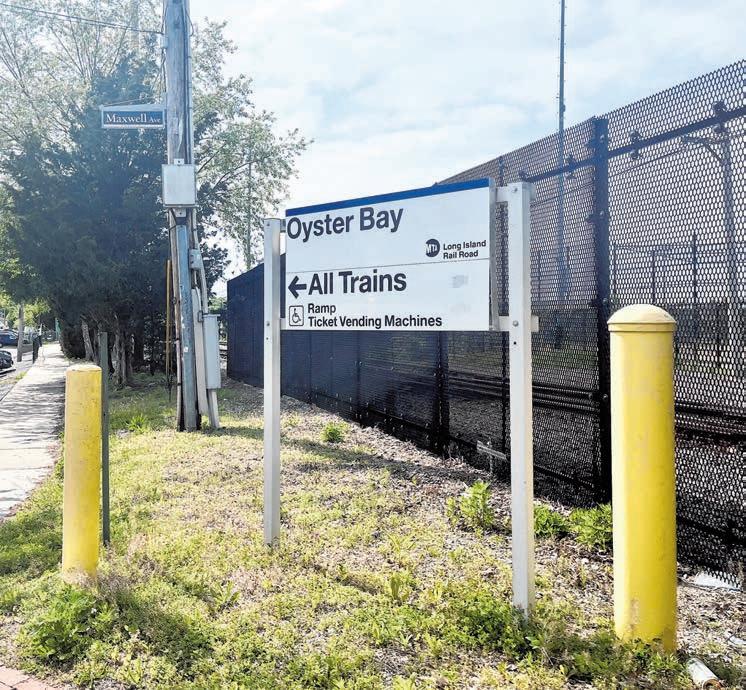
3 minute read
JENNIFER CORR
jcorr@antonmediagroup.com
The following is the beginning of a series examining the history of multiple landmarks in Glen Cove and Oyster Bay.
Advertisement
John Specce has always been interested in trains. The retired agent of State Farm Insurance in Oyster Bay, former trustee of the Oyster Bay-East Norwich School Board, a founding member of the Oyster Bay Main Street Association and past president of the Oyster Bay Rotary Club, enjoys the opportunity to spread his wealth of knowledge about the Oyster Bay Railroad Station and the trains that have stopped there with local children and adults fascinated by trains. The Oyster Bay Railroad Station has a very interesting history. When the railroad extended from Locust Valley in 1889, the Oyster Bay Railroad Station, now housing a museum, was constructed by the Long Island Rail Road. It was an active station for 110 years. Before that, the Oyster Bay Branch opened in 1865 and the Long Island Rail Road reached Glen Head in 1865, Glen Cove in 1867 and then Locust Valley in 1869.
“It was built by Bradford Lee Gilbert, who was the architect for the renovation of the building and the designer of the renovation at Grand Central Station back in 1898,” Specce said of the Oyster Bay Railroad Station. “He was a renowned architect and he built other stations. One of them was Bayport and another one was Southampton.”
When Theodore Roosevelt, who called Sagamore Hill his lifelong home, became president, the building was expanded and spruced up, because there was going to be an increase of activity there from politicians, dignitaries and heads of state. Even President Roosevelt used the railroad to travel to and from his home. “The station remained in service until about 1998,” Specce said. “That’s when the railroad switched from the low [level] platform to the high platform because they brought new equipment in like double-deckers and BiLevel Coaches. They can’t access them at a low-level platform. So they moved the station to the west for the high-level platform and they de-commissioned this building.”
The building was given to the Town of Oyster Bay, and the town wanted to turn the building into a museum, Specce explained.
“They appointed the Oyster Bay Histori- cal Society towards that goal,” Specce said. “Unfortunately, or fortunately, the Oyster Bay Historical Society was involved with a lot of other things at the time. They just couldn’t handle it. So with negotiations, they transferred it over to the Oyster Bay Railroad Museum to become the permanent home. And that’s where we are today.”

In 2004, the historic structure was designated a New York State Landmark. The following year, the building was listed on the Federal Register of Historic Places. Before getting the building, the Oyster Bay Railroad Museum existed in a different form. The museum had a display yard where museum-goers can look at railroad
Specce explained that once the station was transferred over, the ceiling, which contained heating, ventilation and air conditioning equipment, was removed to restore the ceiling to look as it did during President Roosevelt’s time. The southern and western facade of the building has also been historically restored.
“Our next project will be the eastern and northern [facade],” Specce said. “We’re going to restore that also. If you go outside, you’ll see the back is much different than the front. A lot of paint had to be chipped. A lot of brickwork had to be done. And just recently, two handicapped bathrooms were installed. We don’t have any heat, we don’t have air conditioning. But we have running water, we have bathrooms, we have electricity, so we’re operating.”
This summer, the Oyster Bay Railroad Museum has much to be excited about. At the Oyster Bay Railroad Museum’s display yard, museumgoers will now have the chance to ride vintage trains like Caboose #12 on a turntable. They will be able to board the caboose and it will roll out on tracks to the turntable, where it will be spun around two or three times. Then, the train will return back to where the passengers boarded.
“A ton of work went into this project,” Specce said.
The museum’s Facebook page has continually documented the progress of all the work done by volunteers at the display yard.
A new set of tracks was laid, and a pedestrian grade crossing with ramps was installed over the train tracks, among other repairs and exciting new additions to the rail yard. It’s certainly worth a visit, even if you visited last year. Admission is free for children ages five and under, $5 for children ages 6 to 12, $7 for adults and $6 for people age 62 and over. Member admission is free. For more information, visit obrm.org.









